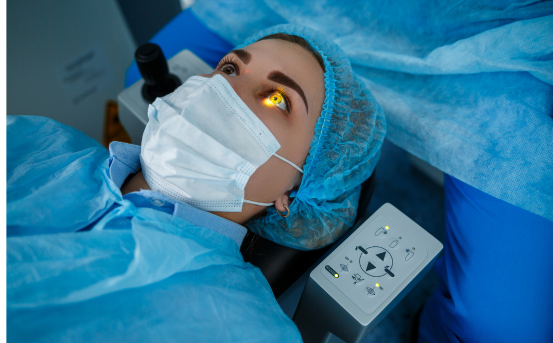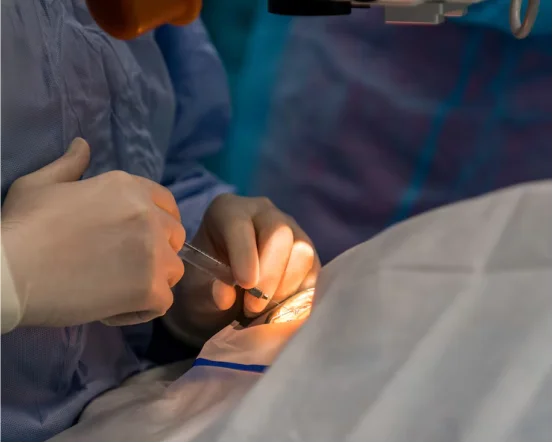Scleral buckling surgery has stood the test of time and continues to be a go-to solution for many types of retinal detachment. It involves placing a flexible silicone band around the eye to counteract the forces pulling the retina out of place. Over the decades, this technique has evolved and continues to offer high success rates, especially in cases with simple retinal tears or breaks.
Our eyes are among the most vital sensory organs, enabling us to perceive and interact with the world around us. Any threat to vision, especially one as serious as retinal detachment, must be treated with urgency and precision. Retinal detachment is a condition where the retina the thin, light-sensitive tissue at the back of the eye pulls away from its underlying layer of blood vessels. This separation cuts off the retina’s supply of oxygen and nutrients, leading to vision loss and, if left untreated, even permanent blindness.
What Is Scleral Buckling Surgery?
Scleral buckling is a surgical procedure used to repair retinal detachment, a condition where the retina peels away from the underlying tissue in the back of the eye. This detachment disrupts the retina’s ability to process light, leading to symptoms such as blurry vision, flashes of light, floaters, and a curtain-like shadow over the visual field.
During scleral buckling surgery, the eye surgeon places a small silicone band (or “buckle”) around the white part of the eye, known as the sclera. This band gently pushes the wall of the eye inward toward the detached retina, relieving the traction or pulling forces and allowing the retina to reattach to its proper position.
Why Is Scleral Buckling Performed?
Scleral buckling is typically recommended for patients with rhegmatogenous retinal detachment the most common type of detachment caused by a tear or break in the retina. The procedure helps :-
-
Seal retinal tears
-
Reattach the retina
-
Prevent fluid from collecting under the retina
-
Restore and preserve vision
It is especially effective in younger patients, those without significant vitreous traction, and individuals with certain types of retinal breaks.
Who Is an Ideal Candidate for Effective Scleral Buckling Surgery?
An eye specialist (retina surgeon) will assess whether scleral buckling is the right option based on several factors, including :-
-
Type and extent of retinal detachment
-
Location and size of retinal tears
-
Age and overall eye health of the patient
-
Presence of other eye conditions (e.g., cataracts, glaucoma)
-
History of previous eye surgeries
In many cases, scleral buckling may be performed alone or in combination with other procedures such as vitrectomy or laser photocoagulation for optimal results.
How Is the Procedure Performed?
Scleral buckling surgery is typically done under local or general anesthesia and may take 1–2 hours. Here is a general overview of the steps involved :-
-
Identification of Retinal Tears :- The surgeon first locates the tear or break using special imaging tools.
-
Cryotherapy or Laser Treatment :- The retinal break is sealed using cryotherapy (freezing) or laser photocoagulation, which helps to bond the retina to the underlying tissue.
-
Placement of the Buckle :- A silicone band is sutured around the sclera. This buckle indents the eye wall and brings it closer to the retina, allowing the break to heal and the retina to reattach.
-
Drainage of Sub retinal Fluid :- In some cases, fluid beneath the retina may be drained to help it lay flat.
-
Closure :- The eye is then closed, and sometimes a gas bubble is injected to support the retina during healing.
What to Expect After Surgery?
After the procedure, patients may experience :-
-
Mild discomfort or soreness
-
Blurred vision for a few days
-
Redness and swelling around the eye
-
Sensitivity to light
Post-operative care is crucial for a successful outcome. Patients will be advised to :-
-
Use prescribed eye drops to reduce inflammation and prevent infection
-
Avoid strenuous activity or heavy lifting
-
Attend regular follow-up visits to monitor healing
-
Sleep with the head elevated as instructed
Full recovery may take several weeks, and vision improvement continues gradually as the retina stabilizes.
Success Rate of Scleral Buckling Surgery
Scleral buckling has a high success rate, with about 80–90% of retinal detachments successfully repaired after one surgery. In some cases, a second procedure may be required. When performed promptly and correctly, scleral buckling can significantly restore vision and prevent permanent vision loss.
Key factors contributing to success include :-
-
Early diagnosis and treatment
-
The location and number of retinal tears
-
Patient’s adherence to post-op instructions
-
Skill and experience of the surgeon
Advantages of Scleral Buckling Surgery
-
Long-term effectiveness :- Proven results in preserving vision for decades
-
Minimally invasive :- No removal of the vitreous (as in vitrectomy)
-
Preserves natural eye anatomy
-
Suitable for phakic eyes (natural lens intact)
It remains a cost-effective and reliable treatment option, especially in younger patients and those without complex retinal pathology.
Risks and Complications
Like any surgery, scleral buckling carries some risks, although complications are relatively rare. Potential issues include :-
-
Infection
-
Bleeding
-
Double vision
-
Cataract formation
-
Increased intraocular pressure
-
Buckle extrusion or infection
-
Need for additional surgery in complex cases
Most of these risks can be managed effectively with timely intervention.
Scleral Buckling vs. Vitrectomy: Which Is Better?
While both scleral buckling and vitrectomy are used to treat retinal detachment, the best choice depends on the specific case.
Scleral Buckling is typically preferred when :-
-
The patient is young and phakic (natural lens present)
-
Retinal breaks are localized and clearly visible
-
No significant vitreous traction is present
Vitrectomy may be better when :-
-
There is dense vitreous hemorrhage
-
Complex or giant retinal tears exist
-
The patient has had prior cataract surgery
-
There is severe traction or membrane formation
In some cases, a combined approach may be used for better outcomes.
Choosing the Right Eye Surgeon
The success of scleral buckling surgery greatly depends on the experience of the surgeon. When choosing a retina specialist :-
-
Check the surgeon’s qualifications and years of experience
-
Look for NABH or JCI-accredited hospitals
-
Read patient reviews and testimonials
-
Ask about post-operative support and follow-up care
Early consultation with a retina specialist can make a major difference in preserving vision and ensuring a full recovery.
Conclusion
Effective scleral buckling surgery remains one of the most trusted and effective methods for treating retinal detachment. With a long track record of success, especially in young patients and those with uncomplicated detachments, this procedure continues to play a vital role in modern retinal care.























